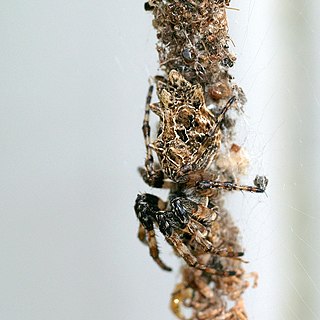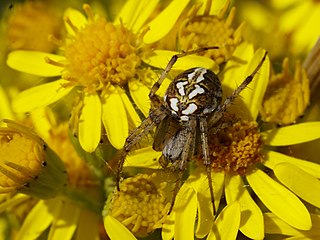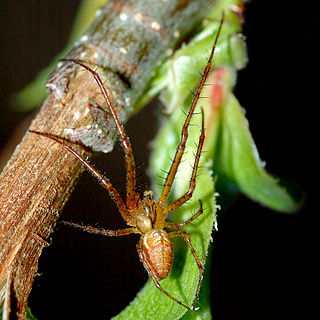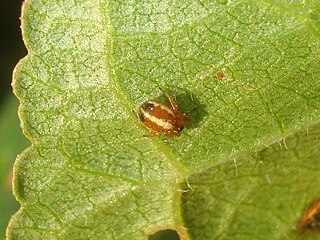
Orb-weaver spiders are members of the spider family Araneidae. They are the most common group of builders of spiral wheel-shaped webs often found in gardens, fields, and forests. The English word "orb" can mean "circular", hence the English name of the group. Araneids have eight similar eyes, hairy or spiny legs, and no stridulating organs.

Araniella is a genus of orb-weaver spiders first described by R. V. Chamberlin & Wilton Ivie in 1942. The genus includes Araniella cucurbitina, the cucumber green spider.

Attulus is a genus of jumping spiders that was first described by Eugène Louis Simon in 1889. The name is a diminutive form of a common prefix for salticid genera, -attus.

Marpissa is a genus of jumping spiders that was first described by Carl Ludwig Koch in 1846. The name is derived from Marpissa, an ancient Greek village.

Alopecosa is a spider genus in the family Lycosidae, with about 160 species. They have a largely Eurasian distribution, although some species are found in North Africa and North America.

Drassodes is a genus of ground spiders that was first described by Niklas Westring in 1851. They are brown, gray, and red spiders that live under rocks or bark in mostly dry habitats, and are generally 3.8 to 11.6 millimetres long, but can reach up to 20 millimetres (0.79 in) in length.

Zygiella is a genus of orb-weaver spiders first described by F. O. Pickard-Cambridge in 1902. In 2015, Parazygiella was determined to be a taxonomic synonym of Zygiella, and its species were moved to Zygiella.

Cyclosa, also called trashline orbweavers, is a genus of orb-weaver spiders first described by Anton Menge in 1866. Widely distributed worldwide, spiders of the genus Cyclosa build relatively small orb webs with a web decoration. The web decoration in Cyclosa spiders is often linear and includes prey remains and other debris, which probably serve to camouflage the spider. The name "Cyclosa" comes from Greek 'to move in a circle', referring to how it spins its web.

Neriene is a genus of sheet weavers that was first described by John Blackwall in 1833.

Neoscona, known as spotted orb-weavers and barn spiders, is a genus of orb-weaver spiders (Araneidae) first described by Eugène Simon in 1895 to separate these from other araneids in the now obsolete genus Epeira. The name Neoscona was derived from the Greek νέω, meaning "spin", and σχοῖνος, meaning "reed" They have a mostly pantropical distribution and one species, Neoscona adianta, has a palearctic distribution. As of April 2019 there are eight species that can be found in the United States and Canada:

Enoplognatha is a genus of comb-footed spiders that was first described by P. Pavesi in 1880. They have both a large colulus and a subspherical abdomen. Males usually have enlarged chelicerae. It is considered a senior synonym of Symopagia.

Metellina is a genus of tetragnathid spiders that occurs mostly in Eurasia, with two species found in North America. M. segmentata was introduced to Canada.

Zelotes is a genus of ground spiders that was first described by J. Gistel in 1848.

Parasteatoda is a genus of comb-footed spiders that was first described by Allan Frost Archer in 1946. The name is a combination of the Ancient Greek "para-" (παρά), meaning "near" or "next to", and the theridiid genus Steatoda. The Japanese name for this genus is O-himegumo zoku.

Larinia is a genus of orb-weaver spiders first described by Eugène Simon in 1874.

Hypsosinga is a genus of orb-weaver spiders first described by Anton Ausserer in 1871. The genus name is derived from the Greek "hypso", meaning "high", referring to the higher clypeus than those of the genus Singa.

Gnaphosa is a genus of ground spiders that was first described by Pierre André Latreille in 1804. They all have a serrated keel on the retromargin of each chelicera.

Micaria is a genus of ground spiders that was first described by Niklas Westring in 1851. They are 1.3 to 6.5 millimetres long.

Singa, also called striped orb-weavers, is a genus of orb-weaver spiders first described by C. L. Koch in 1836. They are small for orb-weavers, reaching 6 millimetres (0.24 in) or less in body length, excluding the legs.




















